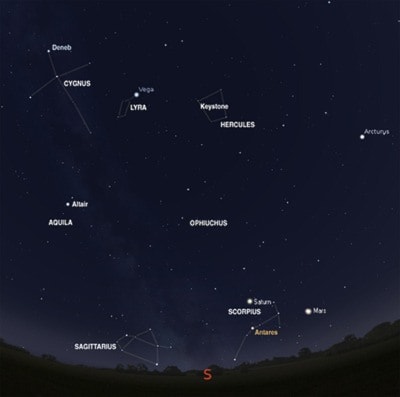What’s up in July’s night skies? Use Saturn as your guide for a tour of the summertime Milky Way.
In the southeast sky over Seattle, Saturn continues to dazzle this month as it climbs up the Salish Walk of the Planets – the ecliptic arc which reaches from East to West.
Saturn’s wide rings and golden colour provide a nice contrast to nearby Mars just up and ahead on the ecliptic, in the south towards Port Angeles.
Below Saturn lies the constellation Scorpius, which really does look like a scorpion!
Through binoculars or telescopes you’ll be able to spot two pretty star clusters, a compact or globular cluster M-4 and an open cluster M-7.
M-7 is known as Ptolemy’s cluster. It was observed and cataloged by Greek-Egyptian astronomer Ptolemy in the first century.
Jupiter is in the southwest – look towards Metchosin and Sooke.
Climbing north, you’ll be able to spot the teapot shape which forms part of the constellation Sagittarius.
The centre of the Milky Way is easy to see – it looks like bright steam rising from the teapot’s spout.
With difficulty, a good star chart and a medium-sized telescope you can locate faint Pluto in the “teaspoon” adjacent to the teapot.
A binocular tour of this centre core of the Milky Way reveals many beautiful summer sky objects.
You’ll have to stay up later to see the northern Milky Way constellations, which are better placed for viewing later in the summer and fall.
We first encounter the Eagle Nebula, M-16. Part of this nebula is featured in the famous and beautiful Pillars of Creation images taken by NASA’s Hubble Space Telescope.
Cygnus the swan features the prettiest supernova remnant in the entire sky: the Veil Nebula.
It’s too big to fit in one eyepiece view, but luckily there are three sections of it.
Look between Aquila and Cygnus to find three tiny constellations: Delphinus the dolphin, Vulpecula the fox and Lyra the lyre (or harp).
M-57, the Ring Nebula, is the remains of a shell of ionized gas expelled by a red giant red star into the surrounding interstellar medium. It’s pretty too!
Look in Vulpecula for the Dumbell, another planetary nebula.
We’ll end our summer tour with Lacerta the lizard and Draco the Dragon.
Lacerta is home to a star with an extra-solar planet in its orbit, and Draco, facing away from the centre of our Milky Way, is a treasure trove of distant galaxies to catch in your telescope.
Night skies fans can catch up on current missions and space telescopes studying our Milky Way and beyond at nasa.gov.
Learn about current missions to comets, Jupiter, Mars and Saturn at www.jpl.nasa.gov and on all of NASA’s missions at Nasa.gov, where you can also learn about NASA’s missions to the planets and beyond.
Should you wish to meet the RASCals of Cattle Point visit us online at facebook.com/groups/VictoriaRASCals/ We also meet at Fairfield Community Centre every Monday at 7:30 p.m.
Dark Skies to all friends of Cattle Point Star Park.
By Bill Smith and the RASCals of Cattle Point – volunteers at Cattle Point DARK SKY Urban Star Park. This summary is from the transcript of “What’s Up in July 2016” by NASA announcer and astronomer Jane Houston Jones, with specific permission for localization to Cattle Point DARK SKY Urban Star Park and the Oak Bay News.
